Glasgow Science Centre
Another day out for UGR-19! Today we were showcasing the car at the Glasgow Science Centre’s Curiosity Live event. We were part of the Ask An Expert group, and had the opportunity to talk to lots of school pupils about STEM subjects and taking part in Formula Student. We’ll also be at the Science Centre over the weekend, so pop by if you’d like a good look at UGR-19!
University Open Day
Today we took UGR-19 out for The University of Glasgow’s Open Day! The Open Day is a chance for students considering coming to UofG to have a wee look around the place. Several team members were standing with the car, and were on hand to answer questions about life at UofG, studying engineering here and Formula Student. We even spoke to one student who was coming to study at Glasgow purely so they could join UGRacing!
Showcasing the Rockers
Name: Christos Schizas
Sub-team: Chassis & Dynamics
Part: Rockers
Purpose of the part: A Rocker is the link which transfers the forces generated by the motion of the car from the pullrod or pushrod to the damper assembly in a formula style inboard suspension. The rocker pivots around a connection with the chassis, making use of ball bearings to minimize friction.
What are the specific features of your design? The rocker assembly consists of two plasma cut aluminium alloy plates with a housing in between containing the bearings and a spacer. Using Finite Element Analysis methods and topology optimization, the load paths were identified and excess material was removed to keep the design at a low mass.
What were the challenges to overcome? Using FEA software for the first time to design something was the biggest challenge. You have to learn how to navigate the interface and provide the correct input and settings to get the desired output. The immense knowledge of other team members and their willingness to lend a hand was the biggest help.
Showcasing the Brakes
Name: Jack Dunlop
Sub-team: Chassis & Dynamics
Part: Braking System
The braking system encompasses the hydraulic circuit and its components which is used to slow down and stop the vehicle. It needed completely redesigned for our new 10” wheels and UGR-19 sees the use of 4 custom Disc Brakes with two separate hydraulic circuits for front and rear. The system uses lightweight callipers and minimal reservoirs along with a bespoke pedal box optimised for driver use. The Stainless-Steel discs are designed to maximise pad bite, have optimal thermal efficiency and be as lightweight as possible. This was the first time I had ever used FEA simulation software, so it was a challenge to set this up however mechanical stress testing was carried out on the brake discs, image below. This system is lighter than UGR-18’s and effectively works with the new 10” Wheels.
UofG Garage Scrutineering
Today the team took UGR-19 down to the University Garage to be scrutineered. The guys who work in the garage kindly do this for us every year and it allows us to be insured. They were very pleased with how the cars looking and so we’re now all ready for testing!
Showcasing the Front and Rear Wheel Hubs
Next up in our Showcasing Series we have the Front and Rear Hubs!
Name: Finlay MacNeill
Sub-Team: Unsprung Mass
Parts: Front and Rear Wheel Hubs
What is the purpose of the components? The wheel hubs are designed to safely connect the wheels of the car to the rest of the unsprung mass assembly and because of this, the rest of the car. The front hubs do just this, whereas the rear hubs have an extra function of transferring the power from the drivetrain and engine into the wheels.
What are the specific features of your design? This year myself and the rest of the USM team made the decision to use different sized wheel bearings at the front and rear. Because we had chosen smaller front bearings this meant we could reduce the size of the front hub axle and reduce its weight significantly when compared to previous designs.
There is a lip feature on both the front and rear hubs that acts as a centering spigot for our wheel so that when the wheels are assembled onto the hubs, the important act of centering the wheel is done by this lip feature, rather than the wheel studs.
Ease of assembly was very important to the team for this year’s hubs and I decided to incorporate a stepped axle into the hub design so that when it came to pressing the hubs into the wheel bearings, there wouldn’t be any unwanted pushing or pulling on unsupported bearing faces that could potentially lead to damage.
Weight saving was also very important for this year’s USM team, especially with our change down to 10” wheels. To ensure that the hubs were as light as possible I introduced some very nice weight saving pockets into both the front and rear hubs. This was done by simulating the hubs using ABAQUS FEA and iteratively deciding where material was at its lowest stress and removing this from the final design.
The first photo is an example of the sort of simulation I was undertaking to remove material.
How did you test the parts? As shown above, the main bulk of the testing and validation for the wheel hubs comes from the FEA conducted during the design stage. There are initial simulations that I completed to see where material could be taken out of the hub designs and then closer to the end of the process, final simulations were completed to see what sort of factor of safety and fatigue life my designs had and if they were adequate enough for the team.
What were the challenges to overcome? The main challenges that I faced when designing these front and rear hubs were mainly down to complexity of working within one of our larger subassemblies on the car. Since we were moving down to 10” wheels this year it required a complete re-design of the USM assembly and that involved a lot of time and effort from everyone in the sub-team to make sure that our parts all worked together seamlessly and prevent any problems with contacting parts, assembly difficulties etc. Thankfully we have a very strong USM team this year and through a lot of double and triple checking as well as countless meetings, we manged to prevent any major problems from arising.
What are the main improvements from last year? The main improvements from this year’s hub designs must be the weight saving. I did manage to reduce the number of components in the hub assembly as well as make them slighter easier to fit together, but with this year’s hub assembly being 30% lighter than the previous one I feel very pleased with that result. That 30% along with the other weight savings in our wheels, brakes and uprights meant that the USM sub-team have saved our car approximately 15 kg for UGR-19!
Final thoughts? I would like to thank Hague fasteners for their outstanding job on the wheel studs for this years’ 2019 hub assembly, the money saved on purchasing these components as well as the strength and security they provide is invaluable, and we are incredibly pleased to have them onboard as part of the UGR-19 team!
Showcasing the Silencer
Over the next couple of weeks we’ll be showcasing various different parts of the car! The designer of each part will talk you through their design decisions, helping you understand the process. First up, it’s Ryan and his Silencer!
Name: Ryan Clark
Sub-team: Powertrain
Part: Silencer
What is the purpose of the component? The purpose of the silencer is to make sure the car is quiet enough to pass the noise test. The rule regarding this states that the maximum permitted sound level is 110 dB(C) an 11,000 RPM, so the silencer aims to attenuate enough of the noise produced by the engine so this value is not exceeded.
What are the specific features of your design? The main change this year was the change of the geometry inside the can. Instead of having a straight pipe through the can, the perforated pipe has two bends in it. This was done in order to increase the sound attenuation of the component, whilst not being restrictive enough to limit the power very much. An image of this, in the software package, and the product received from the manufacturer, can be seen above.
What were the challenges to overcome? The largest challenge faced was the lack of knowledge within the team; this was the first year that someone was specifically tasked with designing the silencer. As it was now being considered with larger importance, it was challenging to teach myself not only how to use the software package to its full extent, but also the theory behind the acoustics involved in the problem.
Which simulations did you carry out? So far, many simulations have been carried out which pointed towards the bent tube design, with a screenshot attached above (last picture).
The graphs plot engine speed, in revolutions per minute, against measured sound level, in dB(C). This curve was produced by the software Ricardo WAVE, and shows the sound level produced by the car as the driver revs the engine higher. The blue line is the sound profile of the silencer used by UGR-18, last years car, and the green the so called “bent tube” silencer. Although the graph does not predict it will be 110 dB(C) or less when it reaches 11,000 RPM, WAVE has not been 100% accurate in its predictions. To combat this, a sound drop of 6 dB was aimed for, as UGR-18 was 6 dB over the permitted level. This bent tube achieves a drop of 8 dB, which should put it below the maximum level. The next step is to test the design on the car and see how closely the results tie in with those achieved in the simulations.
What are the main improvements from previous years? The can is made from aluminium rather than stainless steel, meaning it is significantly lighter. The can is attached to the endplates by rivets, rather than the welding used last year, making it far easier to dismantle the silencer if we need to. The bent tube design discussed earlier will help the silencer attenuate more noise than previous years.
Kames Classic Car Show
Today the team took UGR-19 for her first outing! As part of our Outreach and Engagement program, we were invited along to the Kames Classic Car Show. We got to chat with lots of members of the local motorsport community about Formula Student and our work over the last few years. It was also a great opportunity to promote STEM subjects to some younger motorsport fans, and we think we’ve found this year’s drivers…
A big thanks to everybody who stopped by for a chat with us!
UGR-19 Dyno Session
Yesterday we took UGR-19 to Sitech Racing to improve the engine mapping both for power and efficiency as well as testing the new intake and exhaust system.
We saw good results which the team are all very happy with.
Furthermore, Sitech removed 10-15% fuelling out of the map, meaning we should get pretty good results in efficiency.
The intake previously gave some concern as we didn’t know how well the carbon print would hold up under the heat and pressure cycling, but it appeared to withstand the conditions with ease.
Running the car on the dyno puts the engine and drivetrain under very harsh, sustained loading. It will not see conditions as severe as today during testing or at competition which bodes well for the future!
A massive thank you to Sitech Racing for helping us out.
UGRacing Formula Student Car Launch Event 2019
On Friday 31st May the team had the pleasure of unveiling UGR-19! Here’s a rundown of the night…
We kicked things off with a wee bit of mingling. Drinks were flowing and everyone was very excited for the big reveal. The team had created several posters to hang around the room for guests to look at, including this exploded view of the car (2nd picture).
UofG’s Head of School of Engineering, David Cumming, kicked the night off for us, with a short speech thanking all of our supporters. We then treated the audience to our first video of the night, a round-up of our FSUK 2018 experience.
UGR’s Team Principal, Oliver Neill, spoke next. Oliver spoke of the team’s aims this year, including our focus on outreach and engagement within the local area. He also mentioned the excellent engineering companies that UGR alumnus have gone on to work at, such as Williams, Mercedes and Ferrari F1 Teams, Jaguar Land Rover and Rolls Royce. He then echoed David’s comments, thanking our sponsors and supporters, as well as this year’s incredible team.
UGR’s Team Principal, Oliver Neill, spoke next. Oliver spoke of the team’s aims this year, including our focus on outreach and engagement within the local area. He also mentioned the excellent engineering companies that UGR alumnus have gone on to work at, such as Williams, Mercedes and Ferrari F1 Teams, Jaguar Land Rover and Rolls Royce. He then echoed David’s comments, thanking our sponsors and supporters, as well as this year’s incredible team.
Next up we played everybody’s favourite UGR video: The Tartan Nosecone April Fool’s! It was met with lots of laughter and clapping.
The last speaker was Donald Coutts from The GU68 Engineers Trust. He thanked the team for attending the Trust’s 50th reunion last year, and wished us the very best for the year ahead.
There was time for one last video, a montage of our 2019 antics, before ushering our guests down to the cloisters for the big reveal.
After the sheet covering UGR-19 was whipped off to a huge round of applause, our Head Engineer, Kester Broatch, spoke about the design philosophy behind this year’s car. He then invited our guests for a closer look. Everybody was very complimentary about the car, and we even caught Strathy taking some photos…
Overall it was a fantastic night, and we are incredibly grateful to everybody who came along! Now to get UGR-19 up and running. Let testing commence…




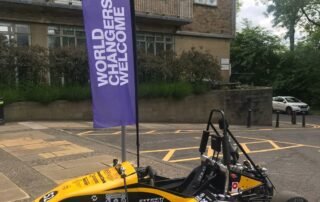
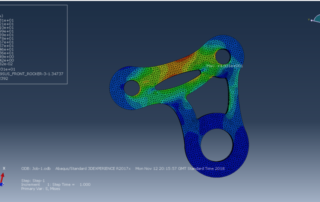
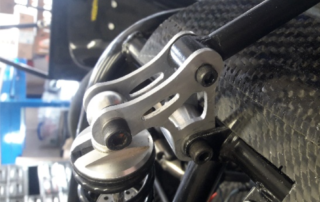


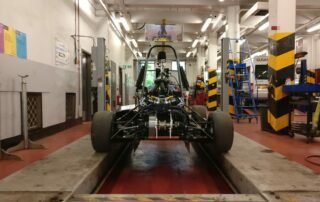
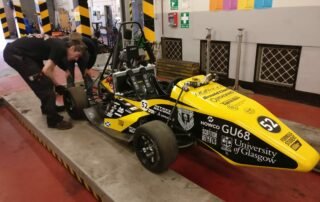
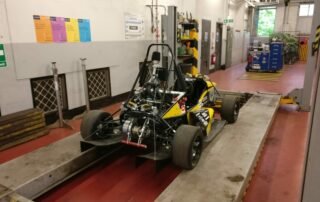
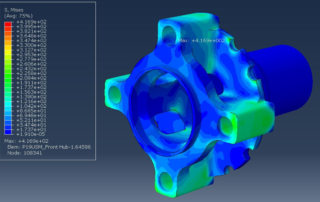

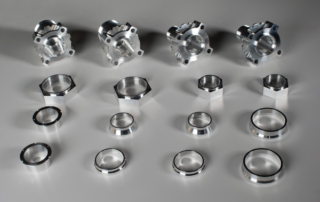
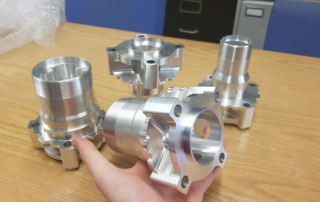

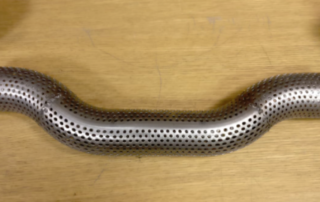
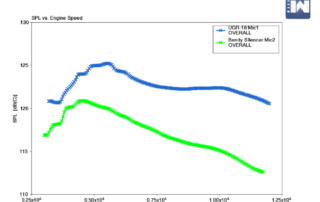
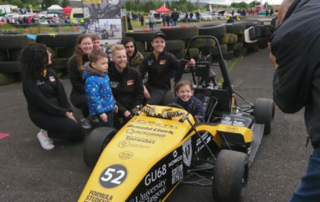
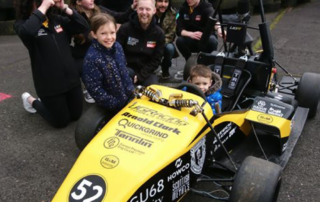
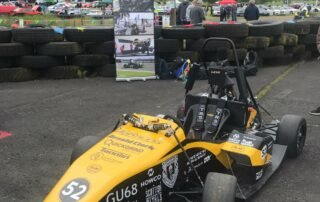
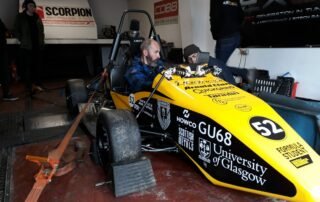
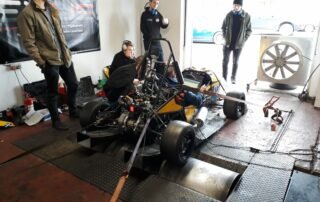

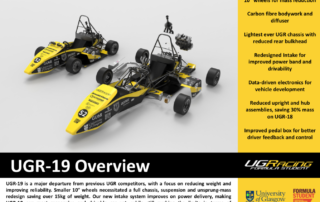
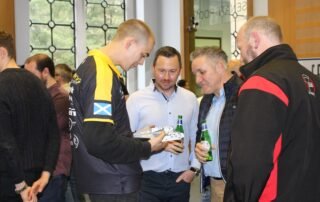


Social